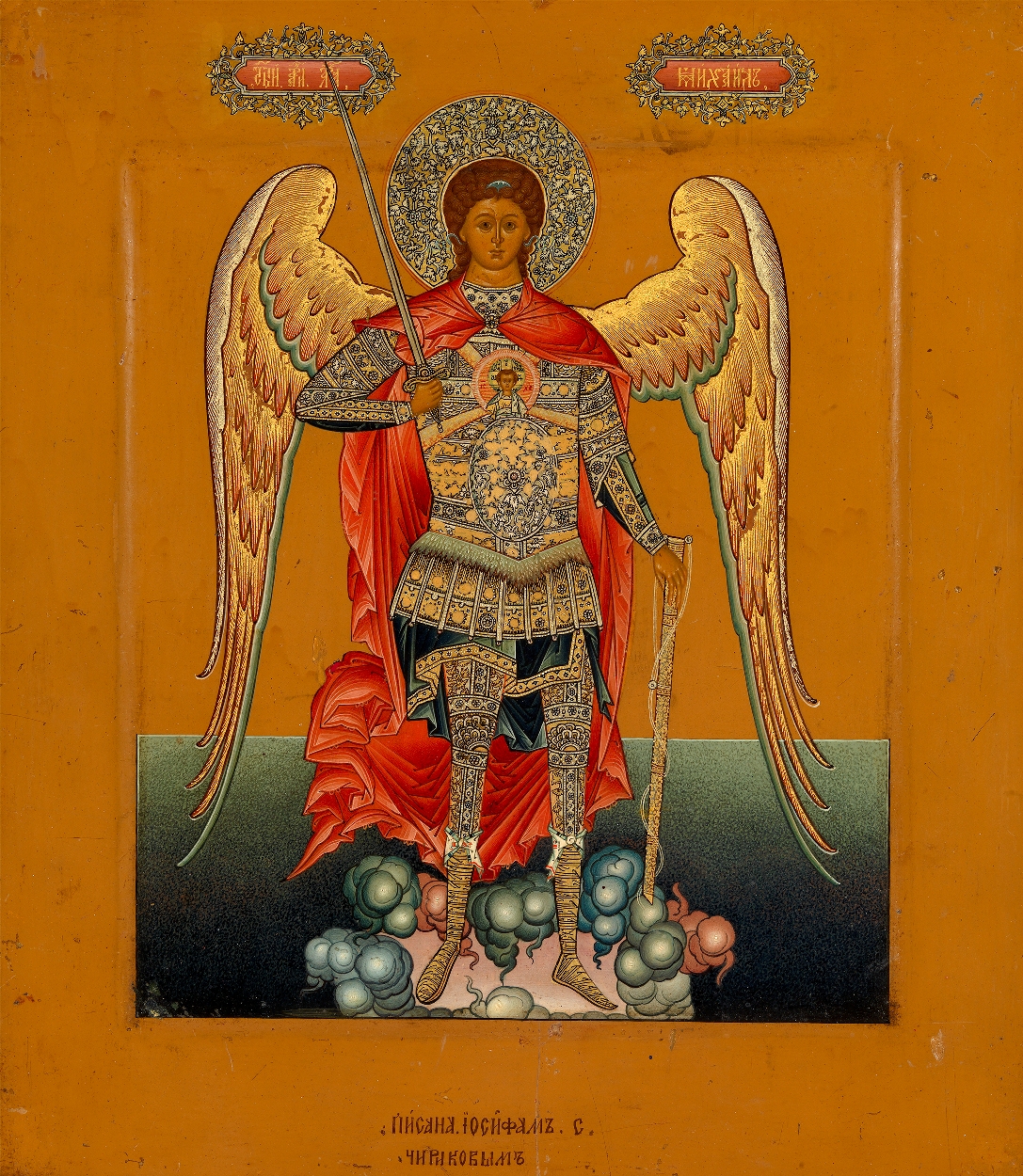25 - 28 November 2012 Russian Art Auctions
25 November 2012

515. THE ARCHANGEL MICHAEL
SIGNED BY IOSIP CHIRIKOV IN CYRILLIC, END OF THE 19TH CENTURY .
31.5 by 27 cm.
42,000–60,000 GBP
Literature: I. Bentchev, Ikony Anjelov. Obrazy Nebeských Poslov (Icons of Anglels. Images of the Heavenly Envoys), Bratislava, 2012, illustrated on the front cover.
Related literature: For similar works, see Dukhovnaya Sreda Rossii. Pevcheskie Knigi I Ikony XVII–Nachala XX Vekov. (Spiritual Environment of Russia. Singing Books and Icons 17th-Early 20th Centuries), Moscow, 1996, p. 117, cat. 29.
Istoriya Ikonopisi. Istoki, Traditsii, Sovremennost’. VI–XX Veka (The History of Icon Painting. Origins, Traditions, Modern Times. 6th-20th Centuries), Moscow, 2002, p. 225, ill. 33.
This finely painted, exquisitely decorated and sumptuously gilded image of the Archangel Michael is amongst the best work of an outstanding icon painter of the late 19th to early 20th century, Iosif (Osip) Semyonovich Chirikov (d. 1903). A native of the ancient icon-painting village of Mstera, Chirikov moved to Moscow, thereby widening the sphere of his artistic interests, experience and commissions. He built on the Mstera traditions to develop his own, inimitable style, thus raising his masterly craftsmanship to the level of high art. His Moscow workshop was widely known, including in court circles.
Chirikov’s distinctive qualities are evident in this icon of the Archangel Michael: its conformity to the rules of Old Russian icon-painting; the multi-layered painting of the face, the rouge and soft highlighting; the various gilding techniques, the abundance of gold hatching and dense foliate ornamentation on the halo and name inscription cartouches. It is noteworthy that these techniques were successfully mastered by Chirikov’s sons too. In 1907 they created a Guardian Angel icon, commissioned as a precious gift for the Grand Duchess Maria Pavlovna, which with its abundance of gilding, halo and border ornamentation, is very close to the present lot.
The artistic merits of this icon and certain peculiarities of the portrayal are evidence that it was commissioned by a high-ranking person. This becomes more obvious when the icon is compared to a similar image painted in 1898 by Chirikov. The 1898 icon has a more traditional background with receding landscape, a graduated sky and richly-ornamented, varicoloured borders giving the impression of cloisonné. The present lot, also late 19th century, appeals to the rarefied taste of a fine connoisseur: the winged Archangel, shining with gold, floats on a cloud, without any other pictorial distractions. Here, the Archangel Michael belongs to eternity and reigns over the world. Comparing these two icons highlights one more singularity: Chirikov chose to emphasise the Chief of the Heavenly Host’s warlike nature: in which he holds a long sword in his right hand and scabbard in his left. In the 1898 icon, an unfurled scroll is borne in the left hand.
The eye is also drawn to the painter’s signature on the bottom border (its graphic quality, superfluous dots and idiosyncratic, phonetic spelling – ‘Iosifam’ – all bear witness to its authenticity). Unlike other known inscriptions, which are smaller and lower down on the image, this one leaps out at the viewer. From all appearances, the artist either wished to underscore his authorship or this was a condition of the commission.
There is no date on the icon, nor any explanatory inscription. It may be that its production was not for a specific event, but for the name day of an important person. Such as for example, the fourth and last son of Emperor Nicholas I, the Grand Prince Mikhail Nikolaevich (1832–1909) — a military leader and public figure. He had the Archangel Michael as his heavenly protector, unlike Grand Prince Mikhail Alexandrovich who was named in honour of the Blessed Prince Mikhail Chernigovsky. We should remember that in the years 1880–1890, Chirikov also carried out a commission for the Marble Palace in Petersburg (from 1832–1888 the palace belonged to Mikhail Nikolaevich’s brother, Grand Prince Konstantin Nikolaevich, and then from 1888–1917 to his son Konstantin Konstantinovich).
The Archangel Michael not only displays the virtuosity and mastery of a widely known icon painter, but may also serve to illustrate the upturn in Russian icon painting as the 19th century ended and the 20th century began. Offering the present lot follows the course set at the previous sale — to exemplify the best of the creative legacy of I.S. Chirikov and his workshop.
Notes on symbols:
* Indicates 5% Import Duty Charge applies.
Ω Indicates 20% Import Duty Charge applies.
§ Indicates Artist's Resale Right applies.
† Indicates Standard VAT scheme applies, and the rate of 20% VAT will be charged on both hammer price and premium.